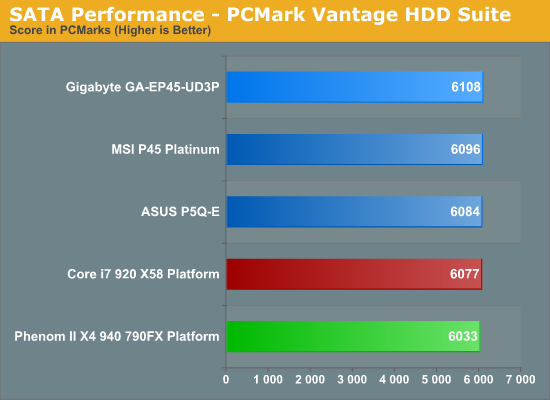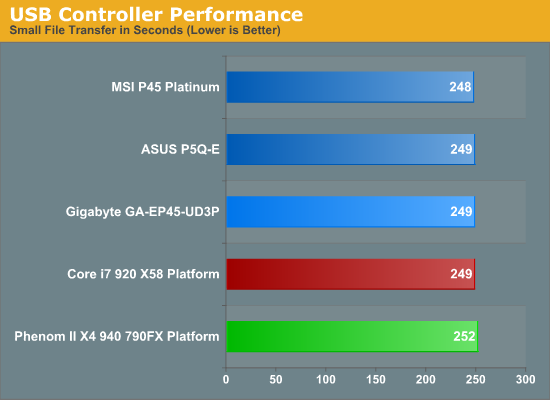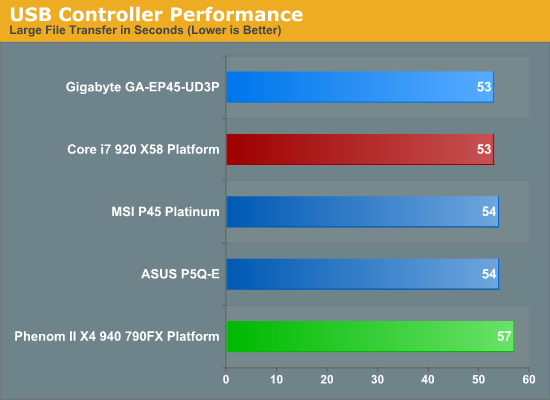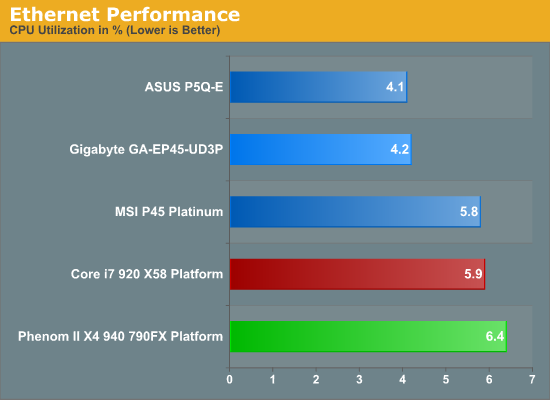Gigabyte GA-EP45-UD3P - P45 at its Finest
by Gary Key on February 3, 2009 12:15 AM EST- Posted in
- Motherboards
SATA Performance
PCMark Vantage is the latest benchmark available from Futuremark, and it is only for use with Windows Vista. Similar to the venerable PCMark05 in its makeup, Vantage modernizes the criteria and test methodology to reflect what users may encounter when running the new Windows OS and current applications. The total HDD benchmark is roughly 87% reads and 13% writes in nature. We run each test five times per drive, producing a median score that we use for comparison in our charts. We enable AHCI settings for each board and download the latest driver set from the manufacturer.

All of the P45 boards utilize the ICH10R for primary storage duties, so there is little difference between the results. ASUS normally finishes first in our storage tests but GIGABYTE was able to pull slightly ahead with the GA-EP45-UD3P.
USB / FireWire Performance
Our USB transfer speed tests are conducted with an OCZ Rally 2 Turbo 4GB Flash Drive and USB 2.0/FireWire based Maxtor OneTouch II external hard drive. In the small file test, we transfer a 602MB folder containing 444 files of various sizes from our hard drive to the USB Flash drive. In the large file test, we transfer a 1.90GB file folder containing 17 different files from our hard drive to the external drive utilizing the USB 2.0 and IEEE 1394a interface.



USB performance is a wash since all of the P45 boards use the same ICH10R chipset that provides the USB capabilities. While our synthetic HD Tune tests indicate parity between the boards, the actual transfer of files in the small file test indicates a slight advantage to MSI's implementation. Our large file USB test basically results in a tie as we are comparing the same chipset and the external hard drive becomes the limiting factor. The VIA and LSI FireWire solutions on the MSI and ASUS boards hold a small advantage over the Texas Instruments chipset on the GIGABYTE board.
Networking
The Windows 2000 Driver Development Kit (DDK) includes a useful LAN testing utility called NTttcp. We used the NTttcp tool to test Ethernet throughput and the CPU utilization of the various Ethernet Controllers used on the Intel motherboards. We set up one machine as the server; in this test, an Intel system with an Intel CSA Gigabit LAN connection. Intel CSA has a reputation for providing fast throughput and is a logical choice for our Gigabit LAN server.
On the server side, we used the following Command Line as suggested by the VIA whitepaper on LAN testing:
Ntttcpr -m 4,0,‹server IP› -a 4 -l 256000 -n 30000
On the client side (the motherboard under test), we used the following Command Line:
Ntttcps -m 4,0,‹client IP› -a 4 -l 256000 -n 30000
At the conclusion of the test, we captured the throughput and CPU utilization figures from the client screen.


Our network throughput test indicates how well a particular controller design from Realtek, Marvell, or Intel performs instead of being indicative of true chipset performance. This also holds true for the CPU utilization results, though this test can also be influenced to certain degree by the BIOS code and chipset interconnect design.
The CPU utilization and throughput numbers favor the Marvell controller on the ASUS board, followed closely by the Realtek chipsets on the MSI and GIGABYTE boards. In practice, few if any users will notice a difference, even if they have the requisite gigabit hub, as storage performance frequently bottlenecks the actual transfer rates.










73 Comments
View All Comments
Glenn - Tuesday, February 3, 2009 - link
On second reading of your original post I wonder if you need to "initialize" that disk within Administrator Tools/computer management/Disk Management ? If it's showing up in device manager that is likely the problem. The cables provided by gigabyte work in any motherboard slot to any internal sata device (HD or Optical Drive) in either orientation.7Enigma - Tuesday, February 3, 2009 - link
You solved my problem! I am now in the process of formatting the drive after initializing. I have NEVER had this issue before as I guess this issue is Vista specific.I cannot thank you enough. I wish this article (and hence my question) had been up a couple days ago and saved me the several hours of wasted life. :(
Now anyone have a good (free?) ghosting program that will allow me to clone my current 80gig drive to the 250gig so I can get rid of the old PATA to use in my old computer build?
semo - Tuesday, February 3, 2009 - link
you've probably never had this problem because your drive already came with an os or the first thing you've done with a new hard drive is to install an os on it. either case, the initialization was done for you.to mirror a hard disk --> http://www.pcinspector.de/Sites/clone_maxx/info.ht...">http://www.pcinspector.de/Sites/clone_maxx/info.ht...
to take a snapshot --> http://ping.windowsdream.com/">http://ping.windowsdream.com/
http://clonezilla.org/">http://clonezilla.org/
get the source and destination right. you only get one chance!
7Enigma - Wednesday, February 4, 2009 - link
I've never directly swapped drives out like I'm trying to do here, but I have added additional drives before (all old IDE) and other than the Master/Slave issue the drives were always recognized upon reboot (with a drive letter already given). I'm sure this Vista method gives more flexibility (can have multiple drives installed but not actually recognized), but it was new and annoying to me.As for the ghost program I think I'm going to use HDclone. While the free version has slow copy times (~1gig/min), I only have an 80gig HD I'm cloning from so I don't mind a bit extra time. And according to their website they claim they now support the extra space when cloning (previously all the freeware ghost programs had the annoying habit of not adding in the rest of the space on the new HD and so you were left with creating another partition, or getting a program like partition magic to do the job the ghost program should have in the first place.
Once again than you very much for all the help and quick advice!
I'll be interested to compare boot times of Vista and games with the new drive. My current 80gig is a 7200rpm Maxtor from several years ago and while the new drive is the same spindle speed I'm assuming that the higher density will allow for quite a bit of an improvement. I'm sitting on the sideline for another year or so before jumping on the SSD bandwagon. Too rich for my blood at the moment, but I drool over them.
strikeback03 - Wednesday, February 4, 2009 - link
In XP when adding SATA drives IIRC it was normal to have to format the drive before it could be used. I don't remember initialization being a separate step though, just format the unformatted space and it would work.7Enigma - Wednesday, February 4, 2009 - link
Just wanted to say I am no running my system on my new Seagate Barracuda 7200.10 ST3250410AS 250GB 7200 RPM 16MB Cache SATA 3.0Gb/s Hard Drive, after a 2hour HDclone that worked flawlessly (and free). Not only that but the new/current version of HDclone also expanded the partition for the new larger drive so I literally just unplugged the old drive after the clone and Vista isn't even complaining to validate again (a fear I had since my copy is Vista Home Premium OEM). I didn't want to try to explain why after building my system 2 weeks ago I'm already swapping the HD....Thanks again!
7Enigma - Wednesday, February 4, 2009 - link
no = *now*7Enigma - Tuesday, February 3, 2009 - link
That sounds exactly like something that may be the culprit. As I mentioned I just made the big switch from XP to Vista, and am not used to some of the Vista policies.I thank you very much for the advice and I'll have to try this ASAP!
7Enigma - Tuesday, February 3, 2009 - link
The bios is pretty confusing when it comes to this (and the manual also doesn't help). I have made sure the SATA bios settings are NOT set to AHCI or Raid, I believe the "off" setting is for it to be seen as IDE.I kinda figured SATA didn't use the Master/Slave, but my concern is that since my primary OS drive IS a PATA drive, that there is an issue with trying to recognize a Master SATA (it shows up as master in the bios, whatever that means).
Another thing is since trying to install the SATA drive (I've since taken it out until I can find some answers) right before Vista loads the windows icon and the logon screen my HD now makes a 5-6 second grinding noise like it's searching the entire drive or something. This never happened before trying to get the SATA drive hooked up, and while it doesn't seem to have affected performance once in windows, it is a bit annoying during bootup (I keep my system off most of the time so on average boot up 2-3 times per day).
The0ne - Tuesday, February 10, 2009 - link
I'm not entirely sure of this myself not having gone through reliable tests but I've been having similar problems with HD's as of late.Make sure you only have one primary HD. If you have multiple HD set as primary, doesn't have to be active, you will run in problems. Vista chokes up as well. Make sure your HD's are labled properly when partition, Simple, Basic, Primary, etc. And then there's the odd external drive like my WorldBook 1TB that, if connected and power on, will 100% prevent XP or Vista to load up fully to the desktop (on my IP35E MB) or 100% crashes and resets the BIOS when XP/Vista tries to load (currently my EP45-DS3R MB). This WorldBook can only be connected once you're on the desktop.
I have a hate relationship with WD external drives, they just want to die in my arms for no apparent reasons.